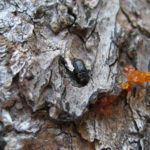Pine Beetle Strategy In Banff National Park Can Do More Harm Than Good, Research Shows
Posted: January 2, 2017Source: National Parks Traveler

While pheromone baiting followed by tree removal — purposefully attracting the pests to a tree, which is then cut down in winter when the larvae are trapped inside — can be successful where there is a dense population of beetles, the strategy can increase the number of beetles in some areas of the Canadian Rockies, according to mathematical modeling led by Rebecca Tyson, an associate professor of mathematics at UBC’s Okanagan campus.
“What our study found is that where the beetle population is low, the pheromone is actually attracting more beetles and thus helping the beetle population increase,” said Ms. Tyson, whose research was recently published in ScienceDirect.
In these areas, the beetles have a hard time finding each other, she said. Additional pheromone, placed by humans, can help attract enough beetles to attack the baited tree.
“With pheromone baiting, this means that humans have put strong signals in the forest that help the beetles find each other. They can then collect in sufficient numbers to attack a tree,” she said. “In these situations, baiting is making things worse for the trees.”
Ms. Tyson described the mountain pine beetle as an endemic pest capable of killing entire stands of mature pine. While the beetle has a short lifespan, climate change and warmer winters have helped the population increase during an epidemic that began in the late 1990s.
The two-year simulation compared four strategies: no management (monitoring only), pheromone baiting, tree removal, and pheromone baiting combined with tree removal. Other management methods are prescribed burning and clearcutting, which Ms. Tyson said cause severe changes to the landscape and have not been proven to stop the spread of the beetle.
The study found that removal of beetle-attacked trees in the absence of baiting is the most successful strategy if managers are able to locate areas with significant pine beetle activity.
According to Ms. Tyson, an adult beetle emerges from a tree each summer and looks for a new one where it will nest. Once selected, the beetle emits a pheromone to attract other beetles to the same tree. Other beetles then arrive, release more pheromone, and the tree is attacked as adult beetles drill into the bark and make tunnels where they lay eggs. By the following summer, the larvae have hatched and turned into adults, and that tree is dead, with the needles turning red. The cycle continues as the beetles move to a neighboring tree.
Under normal population control circumstances, when a tree is baited with pheromone, it is cut down in winter when the larvae are trapped inside, Ms. Tyson said. Crews also search for other trees near the baited one, and all trees identified to contain beetles are removed.
“If all goes well,” said Ms. Tyson, “the beetle population is so severely reduced that it dies out.”
However, her models indicate that pheromone baiting is not working as expected.
“From the field work done in Banff, we know that baiting didn’t stop the beetle epidemic,” she said. “Baiting may have slowed it down, but it did not stop it.”
Tyson was aided in her research by then-Ph.D. candidate Shaun Strohm and University of Calgary professor Mary Reid.

